IR devices that generate heat and light fluxes are actively used in various areas of production and private economy. The most demanded gas infrared emitters for industrial premises. Their action is based on the ability of a heated body to release the received heat into space.
You will learn all about the principles of operation of infrared equipment from our article. We will tell you about the types of infrared equipment and their characteristic differences. We will introduce you to the leading models on the market.
The content of the article:
- The essence of infrared radiation
- Types of infrared radiation sources
-
Dark and light IR emitters
- Features of the device of light fixtures
- The specifics of the work and design of dark heaters
-
Gas burners as a source of infrared rays
- Ceramic flat lance burners
- Ribbed Heaters
- Equipment with metal meshes
- Devices with increased heat output
- Wind Resistant Emitters
- Overview of IR heater manufacturers
- Conclusions and useful video on the topic
The essence of infrared radiation
Infrared radiation is different from ordinary and familiar visible light. They are similar in the speed with which they propagate and traverse space. Both varieties are capable of refraction, reflection and bundling.
Unlike ordinary light radiation, which is electromagnetic waves, the IR flux has both wave and quantum properties. That is, it transmits both light and heat.

Both ordinary light and infrared radiation are streams of electromagnetic waves. The difference is that in the first case the visible component prevails, in the second - the visible component is combined with the thermal
The light supplied by infrared devices travels in waves. Electromagnetic light vibrations are in the spectrum segment from 760 nm (nanometers) to 540 microns (micrometers). The heat generated by IR emitters is a flux of quanta. Their energy ranges from 0.0125 to 1.25 eV (electron volts).
The heat and luminous flux emitted by infrared devices are interconnected. As the intensity of light increases, the quantum heat flux decreases. Depending on the temperature, infrared radiation may or may not be perceived by our eyes. Thermal radiation is not visually detected.
This specific infrared radiation is used in industry to accelerate the polymerization and curing processes. The thermal part of infrared radiation makes it possible to determine the presence and location of a person or an animal in a dimly lit and unlit night period.
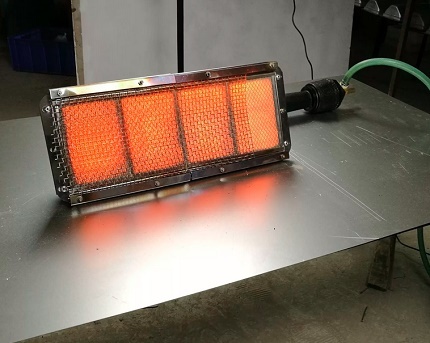
Infrared heaters emit light in combination with thermal energy used to create a comfortable microclimate on camps, in workshops, in production halls, poultry farms, greenhouses and many others objects
The non-standard operation of infrared devices that emit light in combination with heat became the basis for the development of night vision devices. It is used in flaw detection, in hidden signaling devices and in technical devices for photographing at night.
Both components infrared radiation almost do not scatter in the processed space, they seem to focus on objects in the area of their influence. Heat penetrates into the body of the heated object, the depth of penetration depends on the properties, structure and material of the object. The depth varies from a tenth of a mm to several mm.
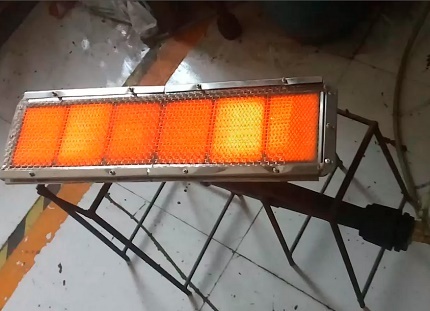
Infrared heaters are floor-mounted, wall-mounted, suspended from the ceiling. The devices are distinguished by flameless combustion, the preservation of oxygen in the surrounding space, they do not raise dust columns, unlike convectors
When used for industrial purposes, the wavelength from infrared emitters is selected based on the technical characteristics of the object or substance. IR rays freely pass through the air mass, therefore heating is performed without tangible losses. This circumstance is reasonably considered a weighty plus in production.
In addition to heating and lighting the area processed by the device, infrared emitters are used in solving the following tasks:
Image gallery
Photo from
In production, infrared emitters are used to accelerate the drying of wood, various films, polymer products
In production halls and auto repair shops, infrared devices accelerate the hardening process of coatings applied to metal and reinforced concrete structures
The unusual properties of infrared rays have become the basis for the development of effective medical equipment used in various fields of struggle for the restoration and strengthening of health.
Sources of infrared fluxes are installed in greenhouses to provide plants with the necessary amount of heat and the light they need for stable growth.
Acceleration of polymerization processes
Acceleration of coating setting
Infrared equipment in medicine
Infrared lamps in the greenhouse industry
Types of infrared radiation sources
The simplest sources of IR radiation are well known to all of us. incandescent lampsoperating under low voltage. In such conditions, they mainly emit infrared streams. In this case, the fraction of light electromagnetic waves is insignificant, but nevertheless it is determined optically.
Now at the disposal of a private consumer, construction and industrial organizations, many different types of IR emitters.
The scope of their application is determined by:
- working temperature;
- the maximum value of the wavelength;
- an area in which the infrared flux is evenly distributed.
Taking into account the listed characteristics, an emitting device designed for solving specific problems is selected.
The most common types of IR emitters are:
- Lamps with mirrored reflectors. At maximum radiation, their wavelength is 1.05 microns.
- Quartz tube lamps. Their wavelength at maximum radiation is in the range from 2 to 3 microns.
- Rod non-metallic heaters. Structurally, they are supplemented with reflectors, the maximum wavelength is from 6 to 8 microns.
- Tubular electric heaters. Devices with heating elements, widely used in everyday life, used in production.
- Infrared burners. They are equipped with ceramic or metal perforated nozzles. They are used in construction for heating open and closed areas during the construction of a building, in the production of finishing works.
Sources of infrared rays are used in farming. With their help, young poultry and newly born domestic animals are heated. Emitters are installed in greenhouses to stimulate the growth of cultivated varieties, in barns and granaries for drying.
Image gallery
Photo from
The most common infrared emitters are lamp fixtures with mirror reflectors. At maximum radiation, its wavelength is 1.05 μm
Lamp and tubular devices (max wavelength 2-3 microns) generating infrared radiation, need to be connected to the mains, therefore they cannot be used on non-electrified facilities under construction
By analogy with tube and tube emitters, rod models (6-8 microns) require power supply. However, among them there are options that can work on both electricity and gas.
Gas burners and stoves are recognized as the most practical and convenient to operate on sites that are not equipped with an electrical network.
Tube infrared emitter
Tubular electric heater
Rod IR source
Gas infrared stove
Sources of infrared streams are divided into:
- Infrared lamps. These are "light" emitters and devices that deliver thermal radiation.
- Heaters. Devices used for heating enclosed spaces and open spaces. These include models that run on electricity, liquid or gaseous fuels. The heating element can be either a heating element or a spiral made of an alloy with high resistance.
According to the classification by wavelength, infrared sources are divided into two main groups: dark and light. The former work by separating long waves into space, the latter - short ones.
Dark and light IR emitters
By definition, "light" sources are capable of emitting light. The streams emitted by them are perceived by sight, although it is still difficult to name them with bright illumination and it is not at all worth using for this purpose.
"Dark" appliances deliver heat that is invisible to humans and is felt by the user's skin, but not visually detectable. The boundary value between "light" and "dark" is considered to be a wavelength of 3 microns. The boundary temperature of the heated surface is 700º.
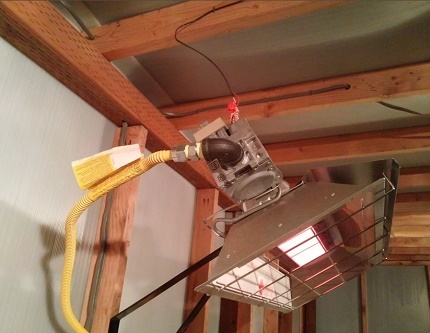
The property of infrared emitters to supply thermal energy is actively used in greenhouses, chicken coops and farms to support young animals
The most famous representative of the "dark" heating unit is brick russian stove, which has been successfully heating low-rise buildings for many centuries. Among the "light" ones, as we already understand, there is an incandescent light bulb, if it supplies no more than 12% of light. At the same time, its main energy is directed to the generation of heat.
Features of the device of light fixtures
Light sources are structurally similar to a typical incandescent lamp. However, there are differences in filament bodies. For light infrared devices, the temperature cannot exceed the limit of 2270-2770 K. This is necessary to increase the heat flux by reducing the emission of light.
Just like standard light bulbs, the tungsten filament is placed in a glass bulb. Only the bulb is equipped with reflectors, thanks to which all the radiant energy is focused on the heated object. In this case, an insignificant part of the energy is spent on heating the lamp base.
The bulb of light infrared sources heats up to high temperatures, therefore it also participates in the process of transferring heat into space. The heat energy from the heated bulb is not focused by the reflector and goes out into the untreated space, it is this component that reduces the efficiency of the device.
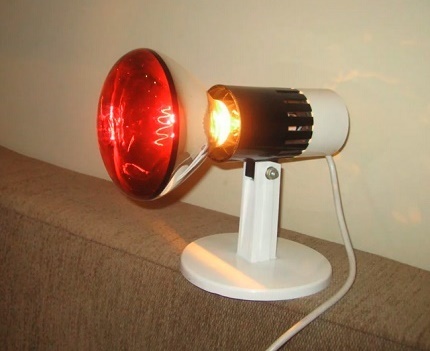
In terms of design and connection method, infrared lamps are very similar to ordinary incandescent bulbs. However, the working temperature of the body of the filament is much lower, due to which the service life is greatly increased.
The productivity of a light infrared source does not exceed 65% on average. It is increased by placing the tungsten heating body in a quartz glass tube or similar bulb. This solution allows the wavelength to be increased to 3.3 µm and the temperature to be reduced to 600º.
This option is used in quartz infrared heaters, in which a chromium-nickel wire is wound around a quartz rod and all this is placed together in a quartz tube.
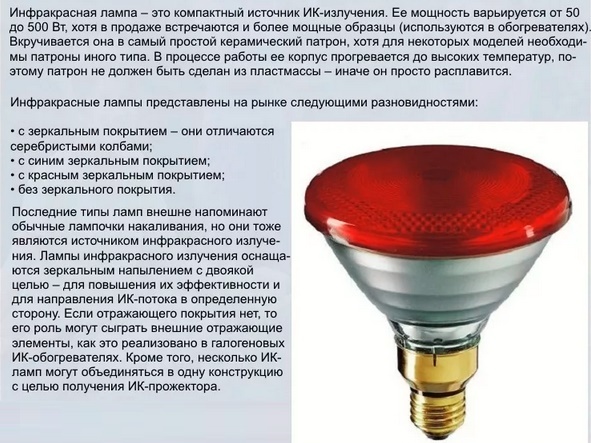
Light infrared emitters are of low performance. The efficiency of their infrared flux does not usually exceed 65%
The essence of the work lies in the double use of the heating wire. The released heat energy is partly used for direct heating and partly for increasing the temperature of the quartz rod. A red-hot rod also emits streams of heat.
The pluses of tubular devices quite reasonably include the resistance of all components made of quartz and ceramics to atmospheric negative. The downside is the fragility of ceramic parts.
The specifics of the work and design of dark heaters
The so-called "dark" sources of IR fluxes are much more practical than their "light" counterparts. Their emitting element is different in structure for the better. The heated conductor itself does not emit thermal energy; it is supplied by the surrounding metal sheath.
As a result, the operating temperature of the device does not exceed 400 - 600º. In order not to waste heat energy, dark emitters are equipped with reflectors that redirect flows in the desired direction.
Long-wavelength emitters of the dark group are not afraid of shocks and similar mechanical influences, because fragile the polymer or ceramic element in them is protected by a metal casing and a protective thermal insulation layer. The efficiency of the emitters of this group reaches 90%.
Image gallery
Photo from
Dark infrared emitters are selected depending on the intensity of the heat flow. The light component is not a decisive characteristic
In order to focus the heat flow on the treated area, IR devices are equipped with reflectors. This allows for increased heating with minimal energy consumption.
Infrared heating emitters work well in open areas. Used not only in industrial premises, but within commercial and private residential areas
Dark infrared heating equipment is recommended for use in rooms with low ceilings
Infrared emitter in a cafe
IR heating device in the production area
Installing the emitter in front of the entrance to the house
Heating IR emitter at home
But they are not without drawbacks. Heaters of the dark group depend on the design features of the device. If the distance between the main radiating element and the surface of the device is large, then it will be washed and cooled by the air flowing by. The efficiency is reduced as a result.
Due to their design features, dark models are installed for heating rooms with low ceilings and areas that require a linear heat supply. Light - placed where processing of rooms with high ceilings and vertically elongated areas is required.
Gas burners as a source of infrared rays
The devices in which the flameless gas processing takes place are called gas burners or gas infrared emitters. The heat energy released with high intensity is transferred to the space through the radiating surface of the unit.
It is gas infrared heaters such as burners that are used on an industrial scale during construction and installation work. The predominant amount of heat energy is transferred by the ceramic nozzles of the burners.
Image gallery
Photo from
The most widespread in the arrangement of industrial and commercial premises, construction sites, sports complexes are gas burners with an injection principle of operation.
Gas burners are flameless combustion devices. In this case, the gas is burned with a high heat intensity on the surface of the main working element
Since the combustion of gas is carried out without the usual flame for us, gas burners can be freely used in open spaces
Gas heaters connected to cylinders with a liquefied gas mixture are taken on tourist routes. They are used in both heating and cooking.
Injection type gas burner
Flameless combustion apparatus
Burner operation in an open area
Gas heater for tourists
Used as attachments:
- perforated ceramic plates, which are flat or embossed;
- ceramic plates with evenly distributed pores;
- ceramic elements with a mesh nichrome screen, mesh metal and all kinds of catalytic nozzles.
All of the above types of holes in a ceramic or metal element are fire channels.
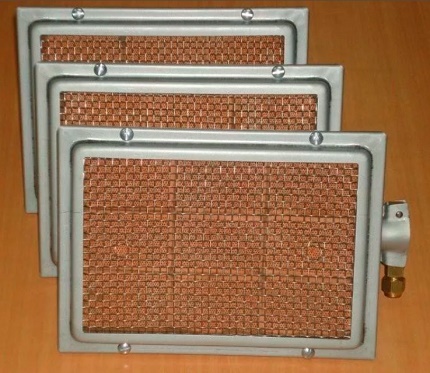
Heat generation by the catalytic packing is based on an oxidation process activated when gas is applied to the plate
The fuel for the operation of this type of infrared emitters is main gas, as well as its liquefied version or artificially created gases. In Russia, they produce burners designed for the processing of liquefied and mainstream gas. Foreign equipment is designed mainly for the processing of liquefied and artificial versions.
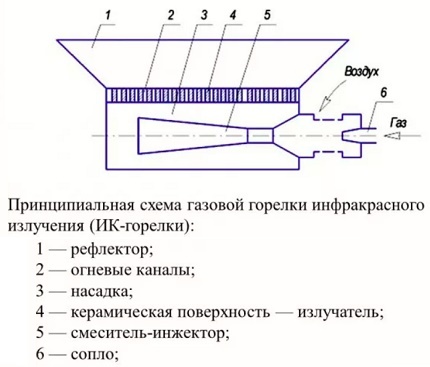
Infrared gas burners process gas with an air mass combustion factor that is virtually equal to one. They work on main, liquefied and artificial gas
If the operating rules are not violated, then the combustion products from the operation of the gas burner are emitted in a minimum amount with an insignificant content of nitrogen oxides and carbon monoxide.
For gas supply, gas infrared burners (GIG) are equipped with nozzles through which the gas is injected at a high speed. This gas supply ensures that the combustion air is injected. It is "pushed" by the high-velocity flow through the injector into the distribution chamber.

A metal structure is placed above the radiating attachment of the device. It increases the efficiency and serves as a support for the dishes, if they cook on the burners
The gas not only injects air, but also mixes with it in the injector, resulting in a gas-air mixture suitable for complete combustion. This mixture moves to the surface of the ceramic nozzle through its pores, perforated holes or slots, where it burns completely in a thin layer no more than 1.5 mm thick.
Ceramic flat lance burners
The predominant amount of heat energy is transferred to ceramic tiles heated to ultra-high temperatures in less than a minute. The outer surface of the ceramic element turns into an additional source of heat flux.
The ceramic nozzle accounts for 40 to 60% of the radiation transmitted by an industrial gas infrared heater. In order to increase the efficiency of the device, a mesh screen is installed above the nozzle. To increase the heat transfer surface, perforated tiles are glued using a refractory putty.
Image gallery
Photo from
Almost all models of mobile gas burners are equipped with devices that allow you to change the position of the body with the heating element
Equipment used in confined spaces is equipped with safety systems that prevent combustion in the event of hazardous situations
The main technical data of the device are indicated on the nameplate attached to the high temperature-resistant housing.
A complete set of information about the infrared emitter can be found in the technical data sheet. It is imperative that you familiarize yourself with it before purchasing.
Using the burner as a hotplate
Equipping with security systems
Nameplate with main technical parameters
Characteristics in the data sheet of the device
An important indicator is the diameter of the firing channels. It depends on what kind of gas the device can process. The total number of holes in the ceramic tile depends on the diameter. The more of them, the more fragile the heat-emitting element will turn out and will be sensitive to mechanical damage to the GIG.
Ribbed Heaters
In addition to flat ceramic perforated nozzles, relief elements are used. The use of a ribbed surface in this case stimulates the flow of heat exchange between the radiating surface and the burning gas. Ribbed ceramic tiles heat up better without increasing the heat load on the emitting element.
Ceramic flat and ribbed nozzles heat up to 1473 K. But porous ceramic elements only up to 1237 K. The porous version is easier to manufacture and therefore cheaper. In addition, waste from the ceramic industry is used in its production.
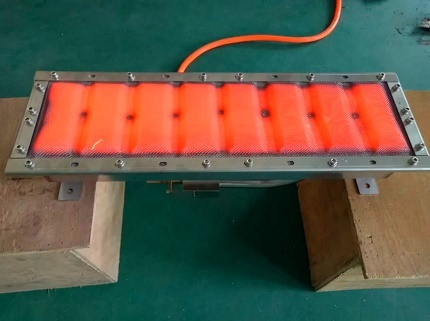
The use of ceramic nozzles with a relief heat-emitting element allows you to significantly increase the area that transfers heat to the consumer
The thickness of the porous tiles reaches 30 mm, which significantly increases the resistance of the nozzle to mechanical stress. During the operation of a burner with such a nozzle, the gas-air mixture that has come out of the distribution chamber burns out on the outer surface of the ceramic tile in a layer of up to 2 mm.
The combustion area in the porous packing moves from the outer surface to a depth of 3-5 mm. At the same time, the heating temperature reaches only 1123 K.
The disadvantage of porous nozzles for GIG is an unnecessarily high hydraulic resistance, due to which it is impossible to use low-pressure main gas in operation.
Equipment with metal meshes
However, all of the above types of nozzles are made of ceramics, which means, despite the thickness and all kinds of tricks of the manufacturer, who wants to increase the strength, they are still fragile. Fragility is especially annoying if the device needs to be constantly moved.
Therefore, a more durable type of burner equipped with a metal double mesh has been developed for heating sites during construction or installation work. In such a device, the gas-air mixture is processed in the space between the nozzle and the meshes. The surface of the outer mesh heats up to only 1023 K.
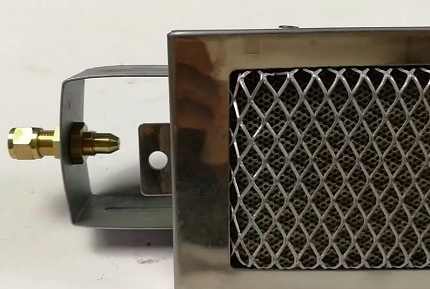
The use of a metal mesh made it possible to significantly increase the thermal power of the IR emitter, as well as protect the ceramic nozzle from damage
In GIG with mesh nozzles, these elements are made of heat-resistant alloys with chromium and nickel. The nozzles are made so that the size of the cells of the upper mesh allows the flame to pass freely, and the lower one is minimal, critical for the breakthrough of fire. Here, IR heat emitters can be both grids or one.
If the infrared burner is processing main gas or propane-butane liquid mixture from gas bottle, only the upper grid is involved in the distribution of heat energy. If a gas with a low load is being processed, both grids radiate heat. In this way, heat transfer is increased.
However, the maximum efficiency of GIG with grids does not exceed 60%, because the hydraulic resistance of the nozzles is twice that of perforated ceramic tiles of all varieties. True, it is less than that of porous nozzles.
Devices with increased heat output
The rather low efficiency of infrared gas emitters with ceramic plates and grids made it necessary to look for ways to increase the thermal power. The result was achieved by the introduction of a new type of nozzle, which is a ceramic panel with a number of slots.
In the cut, the slits have a sudden expansion, their inlets are smaller than the outlets. This solution increases the efficiency of the burner due to the recirculation of combustion products, i.e. their return to the base of the flame within the firing channel. In addition, the flame in such models is more stable and is much less likely to extinguish in the open wind.

To increase the thermal power, various methods are used, one of which is the displacement of the slotted holes relative to each other. This solution also contributes to protection from the effects of wind
The free cross-section of slotted panels is on average 55 - 60% of their real total cross-section. The burners equipped with them operate on medium pressure gas. The outer plane of the packing is heated up to 1723 K.
Wind Resistant Emitters
Stability under wind load is an important factor for choosing a gas infrared burner for construction or assembly of industrial plants. Not all industrial infrared emitters that process gas possess this quality.
For open areas, special devices are needed that:
- are characterized by stable injection, depending on wind gusts;
- equipped with a device preventing the deflection of the jet leaving the nozzle;
- protected from active cooling of the radiation surface due to the influence of winds.
In the data sheet of gas equipment, capable of heating in a gusty wind and not extinguishing, wind resistance is indicated. This characteristic for serially produced infrared burners is approximately the same as for direct, i.e. frontal wind action, and with side blowing.
Image gallery
Photo from
Wind resistance is an important indicator for large-scale industrial premises, especially if they are equipped with a powerful ventilation system
Wind resistance is important for those purchasing heating appliances for installation in within the entrance group, in front of a frequently opening door, on glazed or open verandas, terraces
Those wishing to purchase wind-resistant equipment should know that when the wind pressure decreases, the efficiency of these devices also decreases
In order to correctly select the device, you need to find out how much its performance decreases when the wind load drops, and take into account local weather conditions
Infrared emitter in a production workshop
Wall mounted infrared heater
Gas processing with wind-resistant equipment
Windproof burner in the open area
Reducing the injection ratio causes a flame to appear on the outer surface of the radiant panel. At the same time, the temperature drops sharply. Reduces its cold air penetrating the combustion area.
Wind resistance is physically related to the specific heat load and the volume of air supplied to the nozzle during the combustion period. With excess and high air flow rate, the efficiency of the infrared emitter is reduced. It is accompanied by a reduction in the appearance of tongues of flame, darkening of the emitting surface and the termination of the operation of the unit in a flameless mode.
Overview of IR heater manufacturers
Gas appliances for the formation of a favorable microclimate at a construction site, in a workshop, a production workshop and similar facilities are produced by both domestic companies and foreign firms.
According to consumers, the rating of Russian-made products is led by gas burners of the Solyrogaz brand. The range presented by this company includes models designed for heating areas of various sizes. The units can be used in greenhouses, garages and outdoor areas.
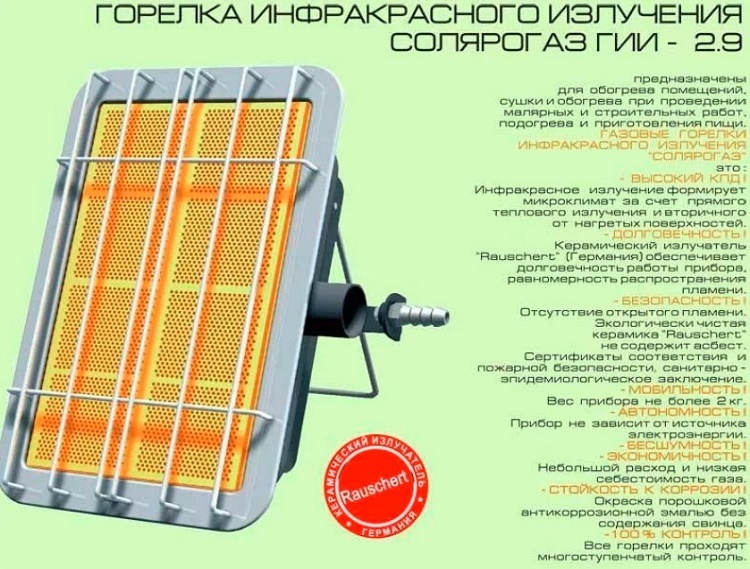
One of the most demanded in the domestic market and proven in practice, the type of gas infrared equipment is a line of gas burners and stoves from the Solyrogaz company.
The only drawback that buyers and real owners of models of gas burners and stoves from a metropolitan manufacturer should take into account is the lack of security sensors. In view of what they can be used in everyday life, but with the observance of precautions.
Not inferior in popularity to products from the Pathfinder company. However, the product line offered to the buyer is dominated by products for household use and tourist options.
Image gallery
Photo from
Safe and trouble-free working Pathfinder gas burners, which have proven themselves in difficult and extreme conditions, are quite popular.
Pathfinder's assortment includes an extensive range of gas burners with collet and threaded connections for connecting cylinders of all popular formats
The package of tourist and industrial gas burners includes an adapter that allows you to connect the device to a collet cylinder
The gas burner is supplied with everything that is necessary for the operation of portable equipment. It is easy and convenient to use in the field
Tourist Gas Burner Pathfinder
Cylinder connection device
Adapter for connecting to a collet cylinder
Complete set of mobile gas burner
Tiles used both in heating and in the preparation of simple dishes are quite popular, and mini spray burner.
Gas heaters with the Aeroheat logo received excellent characteristics from consumers. This equipment attracts with reliability, justified by the use of high quality components, and affordable cost. Gas-fired stoves and burners from Dixon and Sibiryachka have proven themselves well.
The list of worthy gas heaters from foreign suppliers is headed by gas burners and stoves from the South Korean company Kovea. The brand's products are actively used in small workshops, at painting and construction sites, in hiking and fishing.
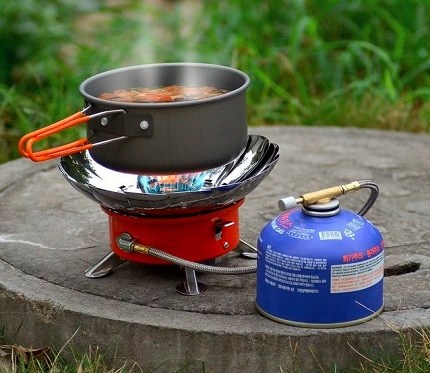
Gas stoves and burners from Hyundai in terms of quality and technical characteristics are not inferior to devices from European manufacturers. According to some indicators, they even surpass
For the arrangement of workshops, gas heaters from the Italian company Sistema are often used. Models from the South Koreans Hyundai, Italian gas stoves Bartolini, which can be used both in everyday life and in the office, are actively in demand. The Swedish Timberk stoves and the Chinese Ballu equipment are distinguished by their reliability and stable operation.
Conclusions and useful video on the topic
The author of the following video will tell in detail about the principle of operation and advantages of IR gas burners:
Details of the organization of infrared heating are presented in the following video:
The installation steps for a ceiling-type gas fired heater are shown here:
In the Russian Federation, different types of infrared burners are produced, including wind-resistant models. The assortment offered by the company allows you to choose a device for heating open and closed areas.
It is important to decide before buying for what purpose and in what conditions the equipment will be used, then choose either a more productive or durable model that is not afraid of multiple displacement.


